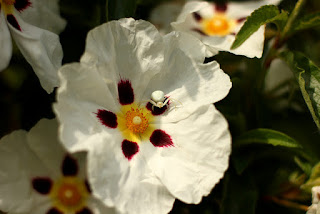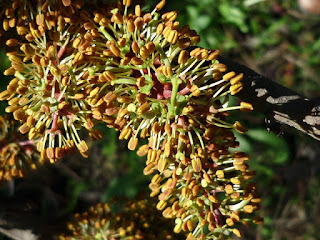By Helen Roberts
A recent talk to the Friends by Dr Chris Thorogood on the flora of the western Mediterranean was tonic for those of us longing for warmer weather. For Chris, the western Mediterranean has always had great appeal having spent many summers teaching field courses to undergraduate students at the University of Bristol and the last five years conducting fieldwork for his new book, a field guide to the area.
“The flora of the Western Mediterranean is really special. The plants are able to grow in some fascinating but really harsh places,” explains Chris. “Because of these severe conditions, plants have evolved numerous coping mechanisms in order to survive.”
The region is extremely rich botanically, with over 10,000 different species, all of which are specially adapted to particularly taxing conditions. The area covers a huge geographical expanse incorporating the westerly Portuguese Algarve, to Italy in the east, the islands (Balearic Islands, Corsica and Sardinia) and North Africa from Morocco to Tunisia (see my post last week, which discusses these regions in more detail).
A bounty of habitats: scrubby landscapes
There is a diverse range of floral habitats in the region from the scrubby maquis to forests with wonderful understories of orchids. The bare and arid habitats are home to ‘experts’ in drought tolerance; and at the other end of the watery spectrum are the seasonal lakes where deadly predatory plants reside. Humans have shaped the flora as well through thousands of years of agriculture, which has produced a visually evocative landscape throughout the whole Mediterranean basin.
 |
| Cistus ladanifer, the common gum cistus. Photo credit: Henry Bush [via Flickr, CC] |
A habitat that we so often associate with the Mediterranean landscape is maquis, which is specific to the Mediterranean area. It is comprised of spiny sclerophyllous (a fancy word for hard-leafed) tough vegetation, which is specially adapted to cope with severe drought. There are often small trees and shrubs dotted about, often with beautiful understories of bulbs and short-lived annuals. Many of the species are aromatic. Typical species include prickly juniper (Juniperus oxycedrus) and common gum cistus (Cistus ladanifer), both highly pungent plants that are used by the cosmetic industry for their oils.
“The smells that exude from maquis vegetation are wonderful,” exclaims Chris, “and the scent from these aromatic plants just seems to hang on your clothes long afterwards.”
Garrigue vegetation is similar to that of maquis. It differs slightly in that it is low growing in form, occurs closer to the coasts and grows on shallower soils. Due to its close proximity to the coast it is battered by winter storms and winds. The low stature of the garrigue evergreen scrub means that perennials and bulbs are highly visible. The flowering displays in spring are visually spectacular and include wild tulips, crocuses, thymes, mints, helichrysums and lavenders.
Into the woods
The native forests of the western Mediterranean form prominent landscapes occupying quite different terrain than the shrubland regions. The oak woodlands are dominated by the holm and cork oak, with a spectacular understory that offers a refuge for many animals, including the endangered Iberian lynx.
The pine forests of Pinus halepensis and Pinus pinaster occupy coasts and cliffs. Healthy habitats have a particularly distinctive flora and fauna with rarities such as the semi-parasitic Violet Limadore orchid found in the maritime pine forest of Landes in France.
 |
| Ceratonia siliqua, commonly known as the carob tree. Photo credit: Jesus Cabrera [via Flickr, CC] |
Humans have also shaped the forest landscapes of the region to a certain degree. Traditional farming practices in the Mediterranean have created unique assemblages of plants. Olive, carob, fig and almond groves represent landscapes people often associate with the Mediterranean. No other landscape denotes the true essence of the Mediterranean like a grove of olives. The olive is engrained in the lives and culture of the people of the region. Carob groves are also stunning in their composition with the gnarly dark trunks contrasting brilliantly against the green understory. The carob, Ceratonia siliqua, is a member of the ‘peas’ (Fabaceae), the most speciose family in the Mediterranean.
Rare aquatic habitats
Most of the western Mediterranean habitats are dry and parched, but surprisingly there are some wet ecosystems too. These unusual habitats are rare and include some curious species like the carnivorous bladderworts, found in seasonal lakes, which catch insect prey using sticky hairs and trap doors.
“The aquatic habitats of the western Mediterranean are interesting because they are pretty rare,” explained Chris. “Many are only seasonal but they support a wealth of interesting species from tiny forget-me-nots, tongue orchids and the carnivorous bladderworts.”
Tough but not invincible
While the native species of the western Mediterranean might be seen as tough and indestructible in the harsh landscapes they occupy, they are extremely susceptible to invasive alien species (IAS). Chris explained that the
two most invasive plants in the region include certain species of Eucalyptus and Acacia. People assume these species are native, probably because they fit into the landscape visually and they can tolerate harsh climatic conditions. However, both these trees can alter native ecosystems and have a negative impact on biodiversity. Unfortunately, many are still planted as ornamental shrubs despite measures drawn up to prohibit the cultivation of them.
Chris explains the danger of one such exotic: “Acacia cyclops is an invasive species that is likely to become the next big invasive in the western Mediterranean. This species forms a mass of vegetation in barren landscapes due to its ability to cope with extremely dry and saline conditions. Ultimately it outcompetes native species.”
These invasive pests steal native plants’ water and change the biochemistry and microbiology of the soil. The native flora is sensitive because the western Mediterranean is exceptionally biodiverse in a relatively small area, with high levels of endemism, particularly on some of the islands. As well as the threat from IAS, there is also intense pressures on these fragile native habitats from humans due to urbanisation, afforestation, and coastal and agricultural development. Effective and timely conservation measures are vital to ensure the survival of these beautiful and botanically rich habitats before it is too late and they go into decline.
Helen Roberts is a trained landscape architect with a background in plant sciences. She is a probationary member of the Garden Media Guild and a regular contributor to the University of Bristol Botanic Garden blog.

